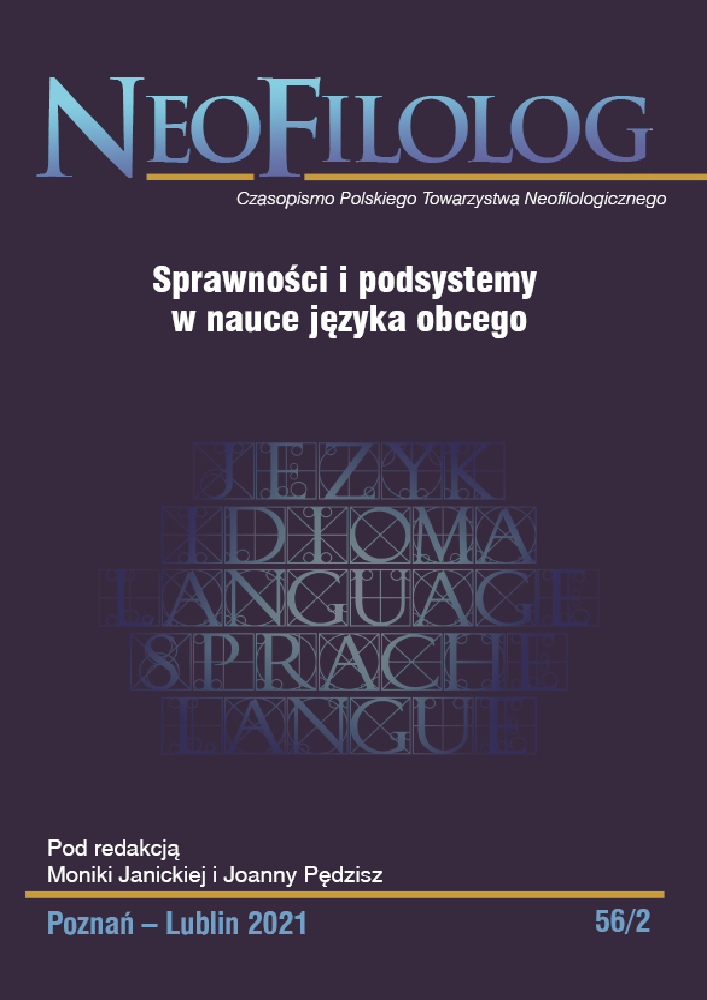Résumé
Sentence adverbials build a multidimensional constituent in many languages, i.e. they can, among others, modify the meaning of the entire sentence, emphasize a particular element in it, or build the coherence in texts. Due to the multifaced character of this linguistic phenomenon the acquisition of it in foreign language learners can be a complex process. The learner is not only faced with a variety of different words and phrases that can be used in order to deliver a complementary information in the text, but also, depending on the structural requirements of the specific language, has to learn to put this constituent in the correct place in the sentence. In present paper the use of sentence adverbials in Polish learners od Swedish will be presented. The data considered in the analysis comprises two types of texts: a summary of an expository text and a narrative. The results show that foreign language learners at the intermediate stage of the language use a broad repertoire of sentence adverbials and place them in appropriate contexts. In narratives modal expressions predominate, while in summaries connectives and intensifiers are used more often. The learners can place sentence adverbials correctly in the sentence, especially in main clauses. However, the word order in dependent clauses when other sentence adverbials occur, except for sentences with the negation inte, is still under development.
Références
Åström, M. (2006), Språkporten - för svenska som andraspråk A och B. Lund: Studentlitteratur.
Biber D. i in. (1999), Longman Grammar of Spoken and Written English. Harlow: Longman.
Bolander M. (1988), „Nu jag hoppas inte så mycke”. Om inversion och placering av negation och adverb i svenska som andraspråk, (w:) Hyltenstam K., Lindberg I. (red.), Första symposiet om svenska som andraspråk. Stockholm: Centrum för tvåspråkighetsforskning, s. 203−214.
Bolander M. (2005), Funktionell svensk grammatik. Stockholm: Liber.
Coste D. i in. (2003), Europejski system opisu kształcenia językowego : uczenie się, nauczanie, ocenianie. Warszawa: CODN.
Grochowski M. i in. (2014), Słownik gniazdowy partykuł polskich. Kraków: Polska Akademia Umiejętności.
Hartmann R., Stork F.C. (1976), Dictionary of language and linguistics. London: Applied Science Publ.
Holm B., Nylund E. (1993), Deskriptiv svensk grammatik. Stockholm: Liber.
Hyltenstam K. (1978), Variation in interlanguage syntax. Lund: Department of Linguistics.
Kowal I. (2020), Satsadverbial i svenskundervisningen — en läroboksanalys. „Scandinavian Philology”, nr 18(1), s. 56−71.
Laskowski R. (1999), Zagadnienia ogólne morfologii, (w:) Grzegorczykowa R., Laskowski R., Wróbel H. (red.), Gramatyka współczesnego języka polskiego. Morfologia. Warszawa: Wydawnictwo Naukowe PWN, s. 27−50.
Levy Scherrer P., Lindemalm K. (2008), Rivstart B1 + B2. Textbok. Stockholm: Natur och kultur.
Lindholm H. (1997), Svensk grammatik. Svenska som främmande språk. Lund: Kursverksamhetens förlag.
Lindström E., Lubinska D. (2019), En deskriptiv longitudinell studie av konnektorbruk i nybörjarsvenska hos vuxna inlärare, (w:) Ljung Egeland B. i in. (red.), Klassrumsforskning och språk(ande). Classroom research and language/lan-guaging. Rapport från ASLA-symposiet i Karlstad, 12–13 april, 2018. Papers from the ASLA symposium in Karlstad, 12–13 April, 2018. Karlstad: Karlstads universitet, s. 61−87.
Mirowicz A. (1948), O partykułach, ich zakresie i funkcji. „Biuletyn PTJ”, nr 8, s. 134−148.
Pienemann M., Håkansson G. (1999), A Unified Approach toward the Development of Swedish as L2. A Processability Account. „Studies in Second Language Acquisition”, nr 21(3), s. 383−420.
Saloni Z. (1974), Klasyfikacja gramatyczna leksemów polskich. „Język polski”, nr 14(2), s. 93−101.
Strutyński J. (2002), Gramatyka polska: wprowadzenie, fonetyka, fonologia, morfologia, składnia (wyd. 5). Kraków: Wydawnictwo Tomasz Strutyński.
Swan M. (2005), Practical English usage. Oxford: Oxford University Press.
Szober S. (1923), Gramatyka języka polskiego. Lwów-Warszawa: Książnica Polska.
Świątkowska M. (2014), O partykułach inaczej. Kilka uwag o problemach terminologicznych, (w:) Bednarczuk L. i in. (red.), Linguistique romane et linguistique indo-européenne : mélanges offerts à Witold Mańczak à l’occasion de son 90e anniversaire. Kraków: Uniwersytet Jagielloński. Instytut Filologii Romańskiej, s. 445−450.
Teleman U. i in. (1999), Svenska Akademiens grammatik. 4, Satser och meningar. Stockholm: Norstedts Ordbok.
Thomson A.J., Martinet A.V. (2001), A practical English grammar. Oxford: Oxford University Press.
Vaakanainen V. (2018), Konnektorbrukets utveckling i finska inlärares L2-svenska, (w:) Sköldberg E. i in. (red.), Svenskans beskrivning 35: Förhandlingar vid trettiofemte sammankomsten Göteborg 11–13 maj 2016. Göteborg: Göteborgs Universitet, s. 341−353.
Wajszczuk J. (2005), O metatekście. Warszawa: Katedra Lingwistyki Formalnej UW.
Licence
© Iwona Kowal 2021

Ce travail est disponible sous licence Creative Commons Attribution - Pas de Modification 4.0 International.
Auteurs :
Les auteurs de textes acceptés pour publication dans la revue Neofilolog sont tenus de remplir, signer et renvoyer à l'adresse de la rédaction, un accord sur l'octroi d'une licence gratuite pour les œuvres, avec obligation d'accorder une sous-licence CC.
En vertu de cet accord, les auteurs des textes publiés dans la revue Neofilolog accordent à l'Université Adam Mickiewicz de Poznań une licence non exclusive et gratuite et permettent l'utilisation de la sous-licence Creative Commons Attribution-NoDerivatives 4.0 International (CC BY-ND 4.0).
Les auteurs se réservent le droit de disposer librement de l'œuvre.
Utilisateurs :
Les utilisateurs d'Internet intéressés ont le droit d'utiliser les œuvres publiées à partir de l'année 2017 sous réserve des conditions suivantes :
- reconnaissance de la qualité d'auteur - l'obligation de fournir des informations sur la qualité d'auteur, le titre, la source (liens vers l'œuvre originale, DOI) et la licence, ainsi que l'œuvre distribuée ;
- sans créer d'œuvres dérivées - l'œuvre doit être conservée dans sa forme originale, p. ex. les traductions ou les interprétations ne peuvent être distribuées sans le consentement de l'auteur.
Tous les textes publiés sont soumis au droit d'auteur.
Autres :
L'Université Adam Mickiewicz de Poznań se réserve le droit à la revue dans son ensemble (mise en page, forme graphique, titre, conception de la couverture, logo, etc.).
.

